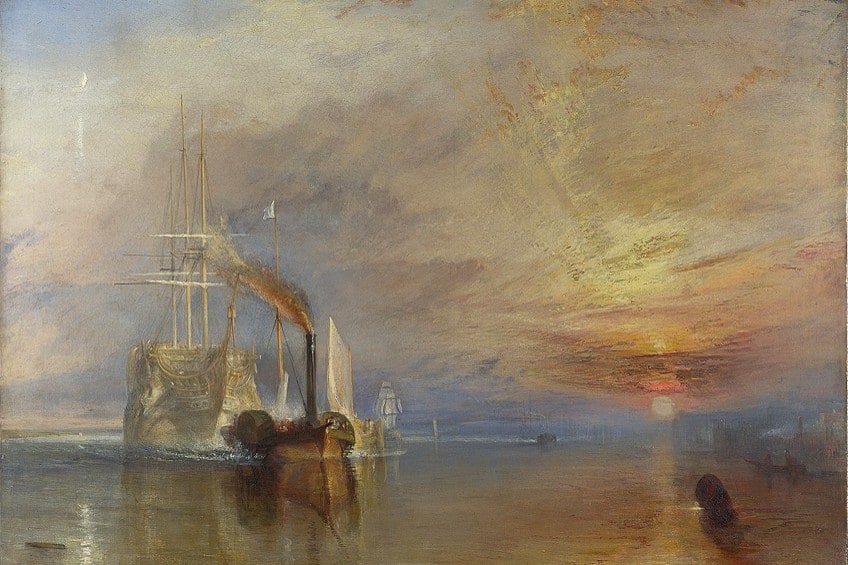“The Fighting Temeraire” by William Turner – The Ship Painting
At first, you might think that The Fighting Temeraire could be about a bull or a raging wild animal, but it is really about a ship. It is a painting by William Turner, who was one of the most beloved Romantic painters. He was famously nicknamed the “painter of light”, whose art techniques would later influence Impressionists artists. This article will discuss his famous ship painting from 1839.
Artist Abstract: Who Was William Turner?
Joseph Mallord William Turner (also known as J.M.W.) was born in London, England. His date of birth was April 23, 1775, and his date of death was on December 19, 1851. He was a Romanticist artist who explored different media like painting and watercolors.
He was known for his landscape paintings, which also explored modern mobile technology like trains and ships.
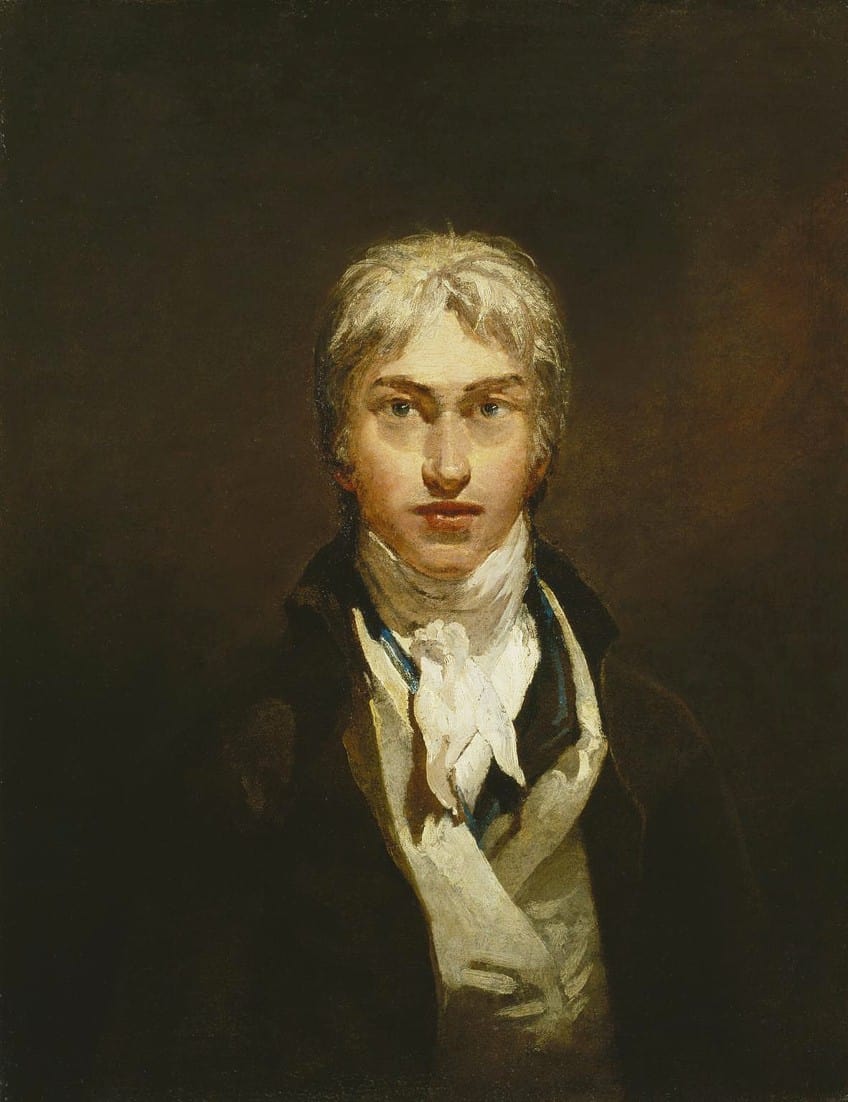
He was nicknamed the “painter of light” due to his utilization and exploration of different lighting effects through colors. This also made him one of the pioneering forefathers of Impressionism. Some of his famous paintings include Fishermen at Sea (1796), The Burning of the Houses of Parliament (1834 – 1835), and Rain, Steam and Speed – The Great Western Railway (1844).
The Fighting Temeraire (1839) by William Turner in Context
| Artist | Joseph Mallord William (J.M.W.) Turner (1775 – 1851) |
| Date Painted | 1839 |
| Medium | Oil on canvas |
| Genre | Landscape |
| Period / Movement | Romanticism |
| Dimensions (cm) | 90.7 x 121.6 |
| Series / Versions | N/A |
| Where Is It Housed? | National Gallery, London, England |
| What It Is Worth | Reportedly never sold and bequeathed to the National Gallery in 1856 |
The article below will discuss The Fighting Temeraire painting analysis in more detail (the full title of the painting is The Fighting Temeraire Tugged to Her Last Berth to be Broken Up). The analysis will start with a brief contextual overview around when Turner painted it, and the significant standing the ship had in England’s military history. It will then provide a visual description and how the art elements compose this famous ship painting.
Contextual Analysis: A Brief Socio-Historical Overview
William Turner, who painted The Fighting Temeraire, was known as a Romanticist artist, a movement during the 18th and 19th centuries that emphasized emotion and expression over the more classical, “logical” and “order-based” ideals from Neoclassicism, which was an art style that preceded it. It also spanned other disciplines like music, literature, and philosophy.
Turner was one of the leading artists from this period and painted expressive landscapes, oftentimes highlighting the intersection between human beings and nature.
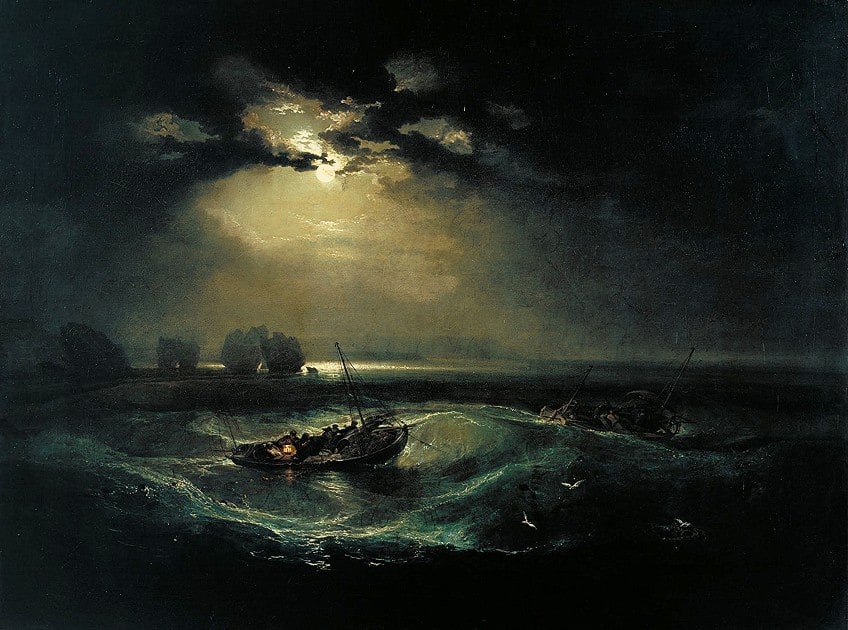
Furthermore, this art movement also included the idea of the “hero” and expressed a sense of self and the individual. Some artists like Francisco Goya also depicted revolutionary scenes, for example in The Third of May (1808) (1814), which touched on political issues when Spanish men were killed by French troops. Another famous example of Romantic art is Wanderer Above the Sea of Fog (c. 1818) by the German artist Caspar David Friedrich. This oil on canvas depicts the enormity of a landscape opening in front of a man standing with his back to us, the viewers.
It exemplifies the vastness of nature compared to man.
Why Did Turner Paint the Temeraire?
The Temeraire undoubtedly held a special spot in Turner’s heart because of its significance within the navy and the artist’s sense of patriotism for his country, England. Let us explore the Temeraire a little bit further to understand why Turner painted this particular ship.
The Temeraire was what is known as a 98-gun ship that was launched in September 1798. The ship was designed by the Navy surveyor Sir John Henslow and built at the Chatham Dockyard in Kent, England.
The Temeraire functioned in convoys and blockades. It also famously fought in its reportedly one and only battle during the Battle of Trafalgar on October 21, 1805. This was between the British Royal Navy and the French and Spanish, the latter was part of Napoleon Bonaparte’s troops. Interestingly, during the battle, the Temeraire came to the defense of another British ship called Victory; the British Royal Navy won the Battle of Trafalgar.
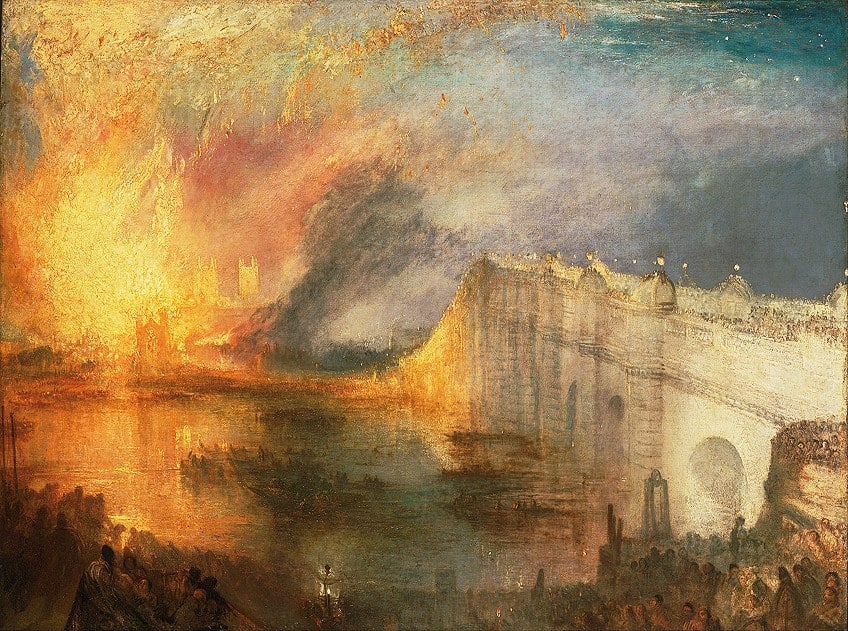
In 1838, the Temeraire was sold to the shipbreaker John Beatson, who was in Rotherhithe in London. Before the ship reached its destination in Rotherhithe it was at the Sheerness Dockyard in Kent where its masts and other reusable parts were removed. The Temeraire reportedly sailed to Beatson’s as an empty ship, towed by two steam tugboats due to its inability to sail.
The event was also in the news at the time and was reportedly a sight worth seeing.
How Turner Portrayed the Temeraire
It is important to note that Turner’s rendition of the Temeraire ship painting was an idealized depiction of the ship’s towing across the Thames and that it was a sort of commemorative gesture to the ship through his artwork. He highlighted the version of the Temeraire as it may have appeared when it was still active in its military service.
For example, some of the differences between the factual story and Turner’s ship painting are the ship’s masts, which Turner depicted as still on the ship, and the tugboats, of which there is only one in front of the Temeraire and one to the side, partially out of view.
The tugboat’s chimney is also depicted in front of the boat, its smoke blowing toward the Temeraire. This has been described as pointing to the symbolism between steam versus sailing, in other words, the emergence of the Industrial Revolution and technology over the older modes of transport.
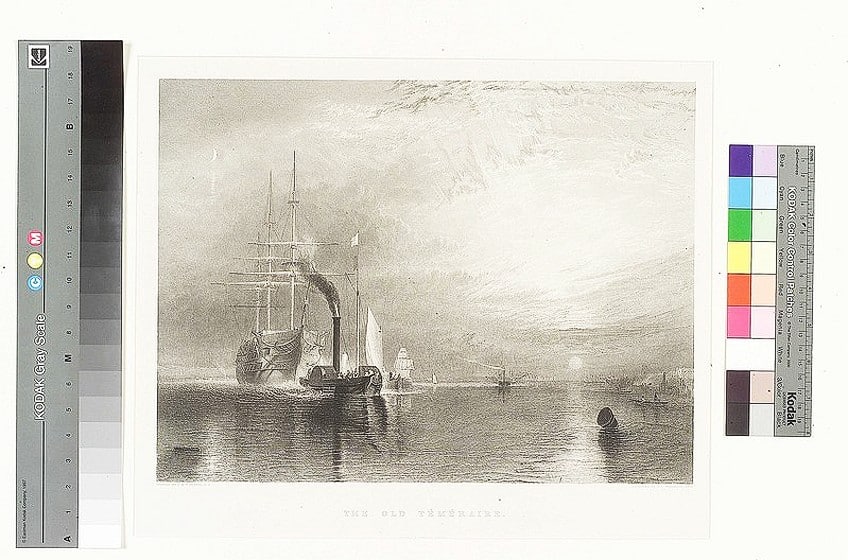
Furthermore, there is a white flag on the ship, which has been described as symbolic of its change of ownership and that it no longer has the significance it used to have as a military ship. It is important to note here that some scholarly sources indicate Turner did not observe the Temeraire’s towing in person, and others indicate he did.
However, both opinions have been questioned and it is important to be aware of this for a wider understanding of the context of this ship painting and why Turner painted it.
The Fighting Temeraire Exhibition
The Fighting Temeraire by William Turner was exhibited in 1839 at the Royal Academy. Reportedly, he also added a literary reference to his ship painting during the exhibition, which was by text from the poem by Thomas Campbell. The poem was from the 1800s and titled Ye Mariners of England. It read as follows: “The flag which braved the battle and the breeze no long owns her”.
There were reportedly positive reviews after its exhibition and it was also noted for how Turner depicted the scene in a more glorified manner, or as some describe “poetic”.
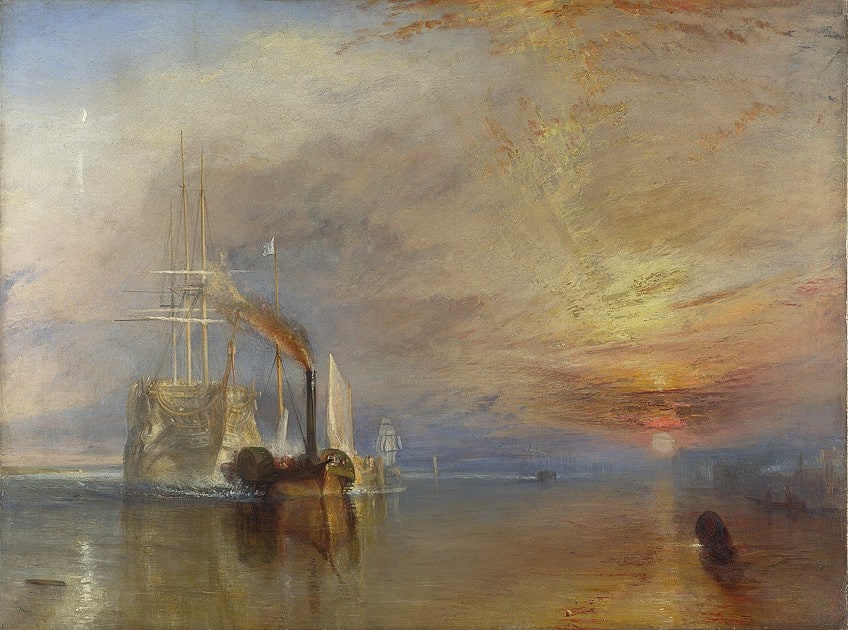
Regardless of the inaccuracies in depicting the facts, the artist depicted the last moments of this ship with some dignity intact. Interestingly, William Turner did not sell The Fighting Temeraire and several years after Turner died the ship painting was bequeathed to the National Gallery in London, England in 1856.
Formal Analysis: A Brief Compositional Overview
The formal analysis below will discuss The Fighting Temeraire in more detail in a visual description and then in terms of its stylistic qualities categorized by the art elements of color, texture, line, shape, form, and space.
Subject Matter: Visual Description
The Fighting Temeraire by William Turner is a landscape painting depicting a scenic sunset and the Temeraire gunship being towed on the Thames River. The right side of the composition consists of the golden orb of the sun, which is nestled between the lower third and upper two-thirds of the painting. The lower third portion of the composition depicts the water of the Thames River. The upper two-thirds of the composition depicts a gilded cloud-filled sky.
Entering the left foreground is the Temeraire gunship, which is being towed by a steam-powered tugboat in front of it. There are other boats visible in the distance to the right, and another tugboat to the left (our right) of the Temeraire.
William Turner created a beautiful contrast of night and day through his depiction of the rising moon in the sky to the left and the setting sun to the right, as mentioned above. This can also be viewed as symbolic in a way, contrasting ideas of old and new.
Color
Rich atmospheric effects are created with color in The Fighting Temeraire by William Turner, and there is a softness and lightness in the overall color scheme. The colors also vary in temperature, which creates a contrast between the left and right portions of the composition.

The left side appears cooler from the blues of the sky and the moon, the grayish hues of the clouds, and notice the triangular shape of blue around the ship. The right side is warmer from the yellows and deep oranges of the sun setting.
Texture
Turner’s brushstrokes are loose and expressive as well as varied in The Fighting Temeraire ship painting. For example, there are thicker layers of paint near the sun, which creates a beautiful dramatism of the sunset. There are also more scumbled areas of brushstrokes, for example in the water and the sky.
Line
The strip of blue sky between the water and sun suggests an implied horizon line. Regarding the types of lines composing the subject matter, there are organic (or naturalistic) lines, notice the curved lines composing the ship, which are subtly contrasted by the straight vertical lines created by the ship’s masts and horizontal lines from the folded sails.

Shape and Form
Shape and form are two art elements that give subject matter its composition, so to say. Shapes can be seen as the basic building blocks that give visual meaning to a form. Furthermore, shapes are usually described in terms of two dimensions and forms as three-dimensional.
There are various shapes and forms in William Turner’s ship painting, for example, notice the circular shape of the sun to the right, the cylindrical form of the floating object on the water to the right, and the square shape created by the sail of the tugboat to the Temeraire’s left.
There is also a contrast between organic and geometric shape and form here, for example, the more structured geometric form of the ship to the left, which contrasts with the more organic and fluid natural landscape of the sky and water.
Space
William Turner creates depth and perspective through clarity of details in The Fighting Temeraire, for example, the objects in the background appear blurrier and hazier compared to the more detailed Temeraire in the left foreground. Additionally, the strip of blue sky underneath the sun also creates spatial depth between the sky and the water.

Turner’s Twist on the Temeraire
William Turner’s ship painting is an ideal example of a Romanticism artwork, a rich display of light and color, but also a visual depiction of an old wartime vessel ushered into its final stages of use. It has been given one last moment of glory, and one that will always be remembered.
This article discussed “The Fighting Temeraire” painting analysis, an oil on canvas by William Turner. It explored when it was painted in 1839 and why the artist chose to depict it in an idealized manner. It also discussed his stylistic techniques – all of which contribute to the vibrancy and emotionalism of this scene and Turner’s twist on the Temeraire.
Frequently Asked Questions
Who Painted The Fighting Temeraire?
The Romantic artist William Turner painted The Fighting Temeraire (1839), which is an oil on canvas measuring 90.7 by 121.6 centimeters. It is a landscape painting that depicts the old gunship, the Temeraire.
What Was the Temeraire?
The Temeraire was a 98-gun ship from 1798, which fought during the Battle of Trafalgar on October 21, 1805. The battle was between the British Royal Navy and the French and Spanish, and the British Royal Navy won. The Temeraire came to the defense of another ship called Victory during the battle.
Where Is William Turner’s Ship Painting The Fighting Temeraire?
The Fighting Temeraire (1839) by William Turner is housed at the National Gallery in London, England. It was reportedly donated by the artist after his death. Reportedly, he also never sold this famous ship painting.
Alicia du Plessis is a multidisciplinary writer. She completed her Bachelor of Arts degree, majoring in Art History and Classical Civilization, as well as two Honors, namely, in Art History and Education and Development, at the University of KwaZulu-Natal, South Africa. For her main Honors project in Art History, she explored perceptions of the San Bushmen’s identity and the concept of the “Other”. She has also looked at the use of photography in art and how it has been used to portray people’s lives.
Alicia’s other areas of interest in Art History include the process of writing about Art History and how to analyze paintings. Some of her favorite art movements include Impressionism and German Expressionism. She is yet to complete her Masters in Art History (she would like to do this abroad in Europe) having given it some time to first develop more professional experience with the interest to one day lecture it too.
Alicia has been working for artincontext.com since 2021 as an author and art history expert. She has specialized in painting analysis and is covering most of our painting analysis.
Learn more about Alicia du Plessis and the Art in Context Team.
Cite this Article
Alicia, du Plessis, ““The Fighting Temeraire” by William Turner – The Ship Painting.” Art in Context. May 19, 2023. URL: https://artincontext.org/the-fighting-temeraire-by-william-turner/
du Plessis, A. (2023, 19 May). “The Fighting Temeraire” by William Turner – The Ship Painting. Art in Context. https://artincontext.org/the-fighting-temeraire-by-william-turner/
du Plessis, Alicia. ““The Fighting Temeraire” by William Turner – The Ship Painting.” Art in Context, May 19, 2023. https://artincontext.org/the-fighting-temeraire-by-william-turner/.


